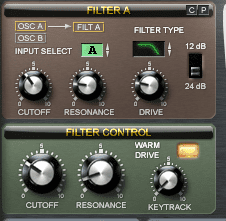
u-he are makers of award-winning software synthesisers and effects including Diva, Repro-1, Zebra2, Hive, Bazille, Presswerk and Satin.
Visit U-he

u-he are makers of award-winning software synthesisers and effects including Diva, Repro-1, Zebra2, Hive, Bazille, Presswerk and Satin.
Visit U-heSynth Secrets is a series of programming tutorials in which we show how to make a range of classic and new synth sounds using plugins such as Massive, Sylenth and Predator.
In our latest Synth Secrets we use Sylenth and its simple arpeggiator to make an 80s-style arpeggio.
Here’s the sound we’ll be making:
Open your DAW of choice, load up an instance of Lennar Digital’s Sylenth1, click on Menu > Init Preset then create a MIDI region and program a single instance of C2 as your note to begin the project. Set it to however many bars you like.
Audio PlayerTo thicken up the sound in old-school style, tune oscillator A1 down by one octave and increase its number of voice to four.
Move right to oscillator A2 and change its waveform to saw (click on the green backlit image alongside the wave display and move the mouse until the central display reads ‘Osc A2 Wave = Saw’). Increase the number of voices to 5, then turn the fine tuning knob to around 0.10 cents.
Ensure that retrig is switched off on both oscillators.
Audio PlayerTo shape the sound, under Amp Env A, set attack (A) to 0.34, decay (D) to 4.50, sustain (S) to 0 and and release (R) to around 5.50.
With the raw sound prepared, activate the arpeggiator by clicking on the the checkbox next to ARPEG in the central display screen. Your plucked sound will now start retriggering.
Now, set the mode to Step. This allows us to customise the notes we want the arpeggiator to play.
To set the speed of the arpeggiator, turn the time knob to 1/16, then set gate, alongside, to 30%.
Finally, set the notes in the transpose row in the order shown in the image below:
Audio PlayerSo far, so good. Now it’s time to bring the sound to life using filters. Move to the Filter A panel, top left. Set filter type to a low-pass filter by clicking and holding on. Flick the switch to the right down to 24 dB. Next, set the drive dial to 2.10, resonance to 2.00 and cutoff to 40Hz.
Beneath Filter A, under filter control, set cutoff to 20 Hz and resonance to 1.00, then switch on Warm Drive.
At this point, you’ll hear barely anything coming out of your speakers.
Audio PlayerTo make the filters sing, head down to MOD ENV 1 and route it to Cutoff A by clicking on the first green drop-down text box beneath the ADSR sliders. Move the knob next to it all the way to the right. Finally, set the decay (D) to 2.76, and release (R) to 3.85.
Audio PlayerThe sound we have is a decent enough sounding 80s arpeggio. To give it a more vintage sound, move down to the LFOs.
Set the LFO 1 waveform to Lorenz by clicking and dragging on the green waveform and checking the reading in the info panel above. Next, select Pitch A from the green text box and turn the dial alongside to 0.10. Set the rate to 8/1T and gain to 1.50.
Move to LFO 2, select a sine wave and from the green drop-down menu choose Phase A. Move the dial alongside to 7.00, set rate to 2/1T and gain to 7.00.
Instant warm, wandering fatness.
Audio PlayerFinally, for a little additional movement, navigate over to Misc 1, set source to Velocity, select Cutoff A from the drop-down menu below, then dial in around 1.14 on the knob alongside. Adjust the velocity to taste.
17th June, 2015

u-he are makers of award-winning software synthesisers and effects including Diva, Repro-1, Zebra2, Hive, Bazille, Presswerk and Satin.
Download the demos and try them for yourself at www.u-he.com
05.22 AM
great post! keep ’em coming! 🙂
07.50 AM
Haha awesome! Thank you !
04.49 PM
“sponsored by U-he” 🙂
02.22 AM
Really helpful!